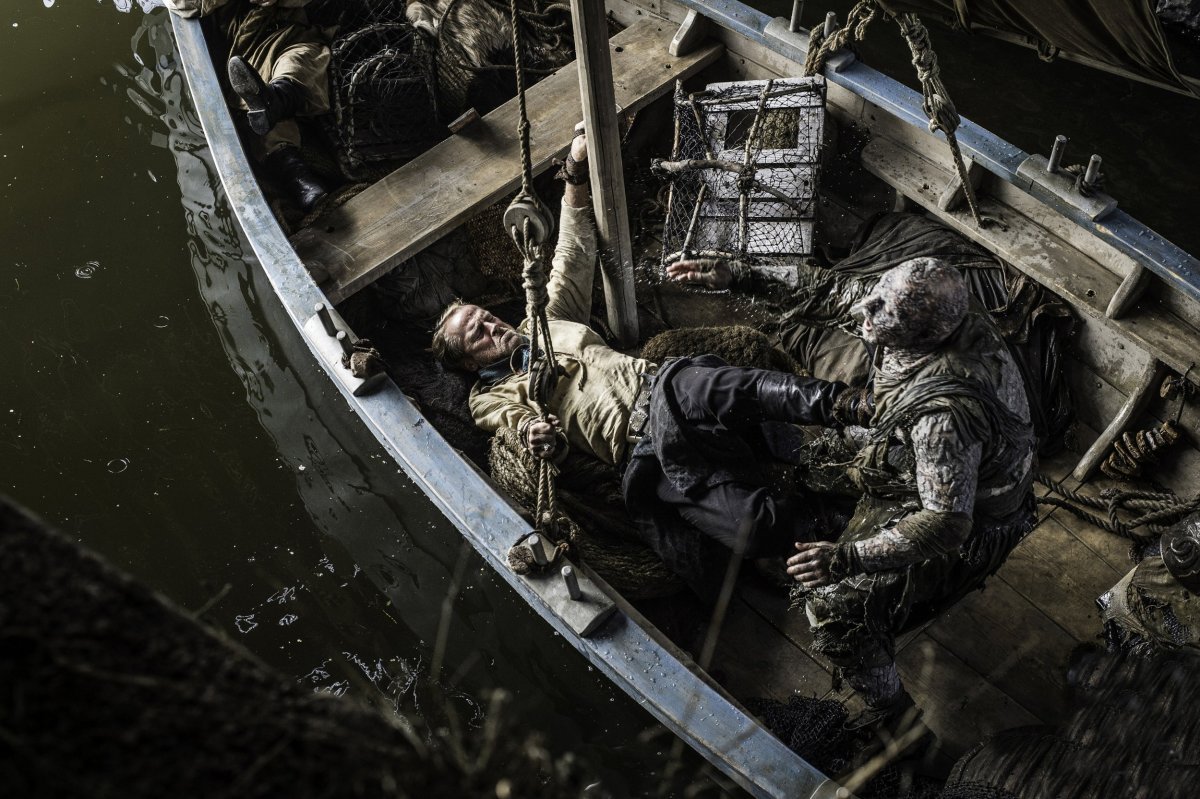Pay close attention, Game of Thrones fans, because greyscale is going to play a big role in Season 7. The fictional medical condition is currently afflicting Ser Jorah Mormont (Iain Glen), the devoted adviser to Daenerys Targaryen (Emilia Clarke), and was also the condition that troubled young Princess Shireen Baratheon in her short lifetime. At the end of Season 6, the benevolent Khaleesi ordered Jorah to go and find a cure for his disease and return to her side when he is back in good health.
In the Season 7 premiere, "Dragonstone," we learned that Jorah's search for a medical reprieve has led him to the Citadel, where Westeros's best maesters have taken him in. In the episode, we saw a brief glimpse of Jorah's arm outstretched through the hatch of his prison cell-like room, suggesting that his condition has worsened since we last saw him. Jorah's disease and his efforts to find a cure will continue to be explored in Season 7. In "Dragonstone," he briefly encountered Samwell Tarly (John Bradley), who has been posted to the Citadel to commence his maester training for the Night's Watch. Their meeting is likely no coincidence—will sweet Sam be the one to save Jorah?
Though greyscale is a work of fiction, created by author George R.R. Martin in his A Song of Ice and Fire novels, it shares similarities with real-life ailments that may have given Martin his inspiration. In Martin's A Dance of Dragons, greyscale is described as a contagious disease with potentially fatal consequences. The condition turns the skin to a stone-like texture and becomes cracked. As time goes on, the prognosis is usually "death, but slow...a year. Two years. Five. Some stone men live for 10," Martin writes. People afflicted with greyscale, dubbed "stone men," like the characters Jorah and Tyrion Lannister were confronted by in Season 5's "Kill the Boy," can become "feeble, clumsy, lumbering, and witless." These poor souls are often shunned from society and live out their days in isolation.
Conditions That Echo the Symptoms of Greyscale
Here are some of the conditions that echo the symptoms of greyscale:
Hansen's Disease (Leprosy)
The most common real-life parallel to greyscale is Hansen's disease, also known as leprosy. The bacterial infection can cause the affected skin to become stiff and dry, patchy, and discolored. It is treatable and nonfatal if treated properly. Hansen's disease is not as common in the United States as it is in countries in Africa and Asia. According to the Centers for Disease Control and Prevention, 2 million Americans are permanently disabled due to the condition. India has the highest number of Hansen's patients in the world, according to the World Health Organization.
Greyscale and Hansen's also share a societal stigma. People with Hansen's, particularly in India, have historically been shunned and ostracized from society, like the stone men in Game of Thrones.
Fibrodysplasia Ossificans Progressiva (FOP)
According to Martin in a featurette for Game of Thrones, greyscale "calcifies the skin...and basically turns them to stone." In the real world, fibrodysplasia ossificans progressiva, or FOP, is a rare condition that has a similar effect. FOP, colloquially called Stone Man Syndrome, is a degenerative condition where bone forms in connective tissues and muscles and "imprisons the body in bone," says the International Fibrodysplasia Ossificans Progressiva Association. FOP is a very rare condition. It affects only one in 2 million people. The IFOPA says there are fewer than 1,000 confirmed cases in the world.

Ichthyosis
Ichthyosis takes its name from the Greek word for fish. It describes a genetic condition that leaves the sufferer with fish scale-like skin. Ichthyosis is generally believed to be caused by a genetic mutation that is inherited, giving the sufferer a faulty gene. It is manageable with a good, regular skin care routine, although there is no cure at present, according to the Foundation for Ichthyosis and Related Skin Types.
In summary, the parallels between greyscale in Game of Thrones and real-life conditions reveal a profound commentary on societal stigmas surrounding diseases. The portrayal of greyscale serves as a reminder of our attitudes towards those afflicted by similar ailments and the importance of compassion and understanding.
For more Game of Thrones coverage, click here.
A Heartwarming Moment: Golden Retriever Recognizes Owner On TikTok
The Journey Of Wordle's Creator: Insights From Josh Wardle
The Drama Behind Team USA's Gold Medal Win At The 2024 Olympics

:no_upscale()/cdn.vox-cdn.com/uploads/chorus_asset/file/6543493/Screen Shot 2016-05-24 at 10.19.09 PM.png)
